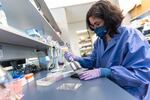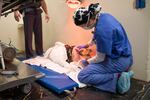We dig into the most interesting, wondrous and hopeful science coming out of the Pacific Northwest, in this monthly rundown from Jes Burns, creator of OPB’s “All Science. No Fiction.”
And remember: Science builds on the science that came before. No one study tells the whole story.
Celestial photobombs

This artistic rendering released by the University of Washington shows the star Gaia17bpp being partially eclipsed by the dust cloud surrounding a smaller companion star.
Courtesy of Anastasios Tzanidakis / University of Washington
Occasionally you just happen to be looking in the exact right spot and see something amazing.
Astronomers at the University of Washington received an alert from the Gaia spacecraft survey about a star in the Milky Way — called Gaia17bpp — that was acting strangely. Over the course of a couple years, the star had gotten significantly brighter.
The researchers analyzed the data and believe the reason is that Gaia17bpp is actually part of a binary star system — two stars that orbit around each other. They think Gaia17bpp rapidly increased in brightness because its relatively tiny (and really dusty) star partner had been eclipsing it from our view.
Looking back at historical observations of the star, the astronomers saw that the eclipse had lasted about seven years. They predict another such eclipse won’t happen again for maybe another 1,000 years. This kind of dusty binary star system is thought to be extremely rare and the dusty eclipse lasted longer than any others known.
The discovery was presented at the 2023 meeting of the American Astronomical Society in Seattle.
Sea sponge cure

In this photo released by the University of British Columbia, Dr. Jimena Perez-Vargas works in the lab.
Courtesy Paul Joseph / University of British Columbia
As COVID-19 continues to mutate and evolve, scientists are working to make sure our treatments for the virus do as well. Researchers at the University of British Columbia are looking to nature as a source for the next generation of antiviral drugs.
They tested more than 350 compounds derived from plants, fungi and marine creatures and found 26 that successfully reduced COVID-19 infection in human lung cells (tested outside the body). Of that group, three worked in small doses. Of those three, two were derived from organisms collected in the Pacific Northwest (within 150 miles of Seattle): a marine bacteria and a sea sponge.
The scientists say the compounds target human cells (helping them recover and block the virus from replicating) instead of the virus itself. And because human cells evolve slower than viruses, there’s hope the compounds would continue to be effective on future variants of COVID-19 and potentially other respiratory illnesses.
Read the paper from the journal Antiviral Research here.
Signs matter
Over the past few decades, there’s been an increased awareness of the complexities of gender. Coming out of this awareness, California and cities like Portland and Seattle have put some rules in place to require gender-neutral bathroom signage.
Well it turns out, signs could matter for more than just access to bathrooms. Research out of Washington State University shows that exposure to all-gender bathroom signage is linked to greater acceptance of transgender and nonbinary people by teenagers.
The researchers conducted an online experiment with more than 300 Americans between the ages of 12 and 17. In one scenario, students were guided through a virtual school that had bathrooms and locker rooms labeled with the traditional man/woman stick figures. In the other scenario, the signs were marked “all gender.” After the virtual tour, the students were polled.
In the short term, those who were in the “all gender” group were more likely to see gender as being nonbinary. In addition, teens who had previously been exposed to “all gender” facilities were more likely to have positive attitudes towards transgender and nonbinary people.
Read the paper from the International Journal of Communication here.
The tiniest of hoops

This image from the University of Oregon shows a new form of carbon-based nanomaterial that takes the shape of interlocking rings.
Courtesy of University of Oregon
When something is measured in nanometers, it’s small — really small. Like DNA small. A sheet of paper is around 100,000 nanometers thick. So chemists working to create new nanomaterials (for their exceptional strength, conductivity and other properties) are manipulating some of the most fundamental building blocks of matter.
Researchers at the University of Oregon have discovered a way to make a new form of carbon-based nanomaterial that takes the shape of interlocking rings. It’s a shape that doesn’t exist in nature, according to the researchers. The properties of the new material can be tweaked by changing the size of the rings and subbing in and out different kinds of molecules.
The researchers believe the new material could eventually be used to create new kinds of sensors, flexible electronics and biomedical materials.
Read the paper from the journal Nature Chemistry here.
Human help for pig ears

This photo released by Oregon State University shows Ella the potbellied pig, who had the first total ear canal removal in a pig performed to relieve her chronic ear infections.
Courtesy of Jens Odegaard / Oregon State University
Sometimes scientists use animals as models to figure out ways of treating humans. It’s a rare day when it goes the other way around.
But for Ella, the rescued 3-year-old Vietnamese potbellied pig living at an animal sanctuary in Veneta, Oregon, the inner workings of human ears have been key to a much more comfortable life. Ella suffered from chronic ear infections, which caused her a lot of pain and hampered her ability to walk.
So a veterinary surgeon from Oregon State University teamed up with a (human) ear doctor from Oregon Health & Science University to perform the first ever known total ear canal removal on a pig. The inner ear structures of pigs and humans are similar, and the team developed a surgical plan based on that knowledge.
The surgery was a success and, aside from a slight head tilt (that could persist), Ella is recovering well.
Read more about the surgery here.
Watch more videos on the science of sleep, a drone that can smell things and the challenge of 3D printing human organs from “All Science. No Fiction.”
